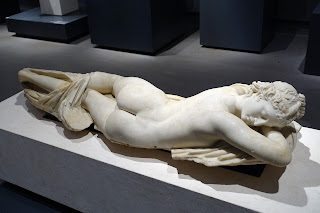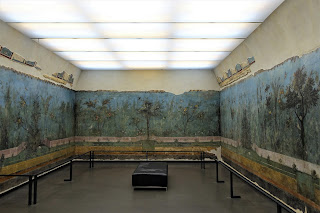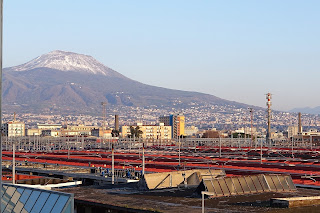Cortina della Pigna, Vatican Museums
On Valentine's Day, my family and I took the Roman Metro to the decidedly unromantic Vatican City (and as for references to priests and underage boys, let's not go there). Having purchased our tickets online (score one for Dad), we were able to bypass the longer queue and gain entry into the Vatican Museums, and proceeded directly to the Sistine Chapel, Michelangelo's 15th-century masterpiece:
Photography inside the chapel is strictly prohibited, as my wife learned when she was admonished by the remarkably-tolerant staff for trying to take a shot of the famous ceiling frescoes with her Smartphone (the following pics, as well as the one above, have been cribbed from the Internet). But what a ceiling it is! The 800 square-meter design presents nine scenes from the Book of Genesis...:
...with the most famous image, of course, being the Creation of Adam, with its depiction of God pointing his finger at Adam:
The other great work of art by Michelangelo in the Sistine Chapel takes up the 200-square-meter west wall. Giudizio universale (Last Judgement) depicts the souls of the dead facing God's judgement - all those nudes were so controversial in its time a pope later ordered fig leaves and loincloths to be added to 41 of the naked figures:
The banning of photography inside the Sistine Chapel forces visitors to take in the magnificent frescoes and paintings with their own eyes as opposed to looking at them indirectly through a camera or cell phone screen, or by way of a selfie. This also allows the Sistine Chapel to be appreciated as the amazing masterpiece that for once lives up to the hype (though the guards were less successful in having the tourist scrum keep its collective voice down, despite the fact it's still a working chapel):
The Stanze di Raffaello (Raphael Rooms) were partially covered up due to restoration work, but the artist's greatest fresco, La Scuola di Atene (The School of Athens), showing scholars gathered around Plato and Aristotle, was still visible:
St. Peter's Basilica makes an appearance as we briefly take a break outside from the crowds:
Among the paintings in the Pinacoteca are Raphael's last work, La Trasfigurazione, completed in 1520...:
...and San Gerolamo (St. Jerome), an unfinished work by Leonardo da Vinci from around 1480:
In the Cortile della Pigna outer courtyard, my daughter poses in front of Sfera, a four-meter-diameter ball by Italian sculptor Arnaldo Pomodoro:
This bronze pine cone was originally a Roman fountain:
Amber in the Cortile Ottagono octagonal courtyard of the Museo Pio-Clementino:
The Apollo Belvedere, a Roman copy of a 4th-century BCE Greek bronze of the god Apollo:
The 1st-century Lancoön, depicting a Trojan priest and his two sons battling a couple of sea serpents:
The centerpiece of the Sala delle Muse is the Torso Belvedere. This 1st-century BCE Greek sculpture was used by Michelangelo as a model for his nude figures in the Sistine Chapel:
The highlight of the Sala Rotonda is this huge red basin that was found at Nero's Domus Aurea:
The spiral staircase, used to exit the museum:
If we had had the entire day to spend at the Vatican Museums, we could've used the time to visit the Chiaramonti, Etruscan and Egyptian Museums, but Shu-E, not the greatest admirer of art from the Western world (nor from the Orient, for that matter) would've been burned out to a crisp by that point. So we left the Vatican Museums following lunch and walked to the expansive St. Peter's Square, where we queued in the security line for forty minutes to get inside one of the world's greatest cathedrals, St. Peter's Basilica:
Looking out to the piazza before going inside St. Peter's:
And as was the case with the Sistine Chapel, the basilica lives up to the hype. Built over a 4th-century basilica, St. Peter's was completed in 1626 after 150 years of construction:
The Pieta, sculpted in 1499 by a little-known 25-year-old artist by the name of Michelangelo:
The entrance to the Cappella del Santissimo Sacramento:
For a look inside the lavishly-decorated baroque chapel (where photography is verboten), I turn once again to Google Images:
Michelangelo's dome rises to a height of 119 meters (390 feet):
The right foot of the 13th-century statue of St. Peter has been worn down by centuries of rubbing and caressing:
The Cattedra di San Pietro (Chair of St. Peter) is also by Bernini. The gilded bronze throne is held aloft by four 5-meter-high saints and is centered on a 9th-century wooden seat:
A member of the Swiss Guard mans his post outside St. Peter's Basilica:
The day's sightseeing completed, we stopped off at the Gelarmony gelateria for a break before returning to our hotel. Amber set a goal for herself on this trip to try at least two different gelato flavors a day while she was in Italy. She succeeded admirably:
Our last morning in Rome was also the last day of the Lunar New Year. While my wife stayed behind in our room to wash her hair and pack up, my daughter and I made the short walk to the Museo Nazionale Romano: Palazzo Massimo alle Terme, one of Rome's best museums. The first and second floors contain some fine examples of sculpture, such as the 5th-century BCE Niobide morente (Dying Niobid)...:
...these two 2nd-century Greek bronzes, the Pugile (The Boxer) and the Principe ellenistico (Hellenistic Prince)...:
...the Ermafrodite dormiente (Sleeping Hermaphrodite)...:
...and the Il discobolo (Discus Thrower), a 2nd-century copy of an earlier Greek work:
The best highlights of the museum, however, are its collection of frescoes and mosaics on the third floor, originally used as interior decorations of Roman villas:
The finest examples are to be found in the room from the Villa Livia, one of the homes of Augustus' wife Livia Drusilla:
The basement contains an impressive collection of old coins, as well as the creepy remains of a mummified 8-year-old girl, the only known example of mummification from the Roman Empire:
From the museum Amber and I walked to the AS Roma official store, where I picked up a replica of last year's jersey (50% off!), passing the Piazza della Repubblica en route:
We then returned to the hotel, picked up Shu-E, checked out and had our last lunch in Rome at the Ristorante Centro:
Afterward, we retrieved our bags and headed over to Roma Termini, to catch the high-speed train to Naples. But not before having time for one last gelato before boarding (our train was the one on the left):
It only took around 70 minutes to reach Napoli Centrale. Our hotel, the Stelle Hotel the Businest, was conveniently located attached to the station. There was a view of Mount Vesuvius from our room:
Thursday the 15th was the Lunar New Year's Eve, an important family occasion in the Chinese world. Shu-E found that the nearest Chinese restaurant was a twenty-minute walk from the hotel. That walk turned out to be through some very dodgy-looking areas. I was expecting to find a small Chinese-style trattoria, but the Ristorante Internazionale Cinese turned out to be a huge banquet hall, filled with circular tables featuring lazy susans, while the big TV on the wall was airing this year's edition of the CCTV New Year Gala (this BBC article reports on a controversy from this year's program). We were one of the first customers, but the place soon filled up with Chinese diners, and for an hour or so it felt like we were back in Shanghai or Taichung, and not in southern Italy:
After dinner we walked back through the same grungy area and returned to our hotel. It wasn't until we were about to leave Naples a couple of days later that I read in my guidebook that walking around Napoli Centrale train station after dark wasn't recommended.
Up next: Pompeii










































































No comments:
Post a Comment